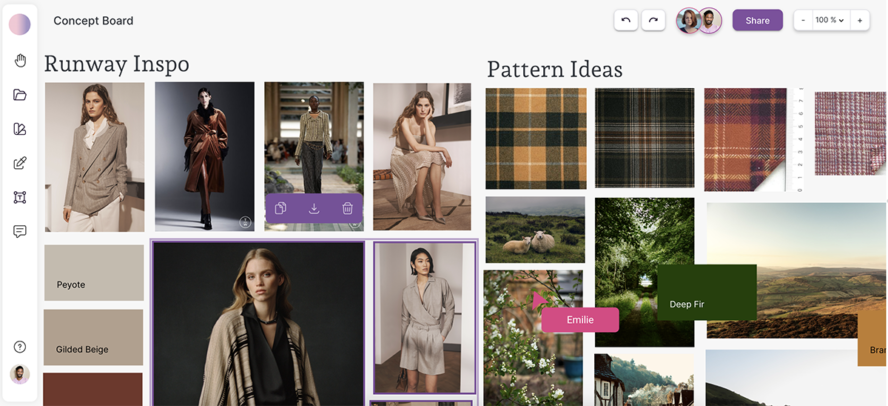As a fashion designer it’s important to visually organize and communicate your design ideas and inspirations. One of the first steps to help set the tone and direction for your collection is to create a mood board. A mood board is a visual tool that captures and communicates the overall aesthetic, mood, and inspiration behind a fashion collection or design project. It is a curated collection of images, colors, textures, fabric swatches, and other visual elements that help set the tone and direction for the creative process.
Fashion designers use mood boards as a means of expressing their vision and translating abstract concepts into tangible visuals. Mood boards reflect the designer’s chosen theme, color palette, fabric choices, and overall style. By bringing together various visual elements, the mood board helps create a cohesive and visually compelling collection.
When we first met Fashion Mingle VIP member and cofounder of Make the Dot, Theren Moodley, we were instantly inspired by the software his company is creating to help designers reduce the time it takes to get a fashion product to market and also the waste that is so common when teams try to collaborate. Make the Dot is used by designers, brands, and even schools such as Fashion Technology Institute (FIT) and is the go-to platform to help you create the perfect mood board for your next collection.

Digital mood board by Make the Dot. www.makethedot.com
10 steps to create the perfect mood board for your fashion collection:
- Define your mood board aesthetic: Start by identifying the concept or theme you want to explore in your fashion collection. It could be based on a specific era, culture, color palette, or even a mood or emotion. Here are some tips from from fashion designers to help you get started on your mood board aesthetic.
- Gather inspiration: Look for sources of inspiration such as fashion magazines, runway shows, art exhibitions, nature, architecture, or even social media platforms like Pinterest and Instagram. Collect images, photographs, fabric swatches, color samples, and any other visual references that resonate with your concept. Check out this advice from a professional pattern maker and learn how she organizes her mood board inspiration.
- Choose a mood board base: In the past, most fashion designers created their mood boards on a large corkboard, foam board, or poster board for a physical mood board. Today, we have so many options for digital mood boards. While you can use software like Adobe Photoshop, InDesign, or even online tools like Canva, there is actually a much superior option created specifically for fashion designers by mood board software company Make the Dot. This digital platform helps you create inspiring mood boards within minutes, allowing you to drag and drop unlimited content, group collections and even add color swatches from their Pantone library.
- Organize your materials: Start arranging your collected materials on the base. Group similar images or themes together to create visual coherence. You can organize them by color, texture, pattern, or any other relevant categories.
- Create a color palette: Identify the key colors that align with your concept. Include swatches or color chips that represent your chosen palette. Ensure that the colors harmonize and convey the desired mood or vibe. You can use Pantone colors or pick your own color palette with this easy online color palette tool.
- Add fabric samples: If you have specific fabrics in mind for your collection, include fabric swatches on your mood board. This helps convey the tactile quality of your designs and provides a better understanding of the overall aesthetic.
- Include sketches or illustrations: If you have initial design sketches or illustrations, add them to the mood board. This gives a glimpse of your design ideas and helps tie everything together.
- Consider typography and text: You can include typography elements or even handwritten notes to add additional context to your mood board. This could include inspirational quotes, keywords, or descriptions related to your concept.
- Experiment with layout: Play around with the arrangement of your materials until you achieve a composition that visually communicates your concept effectively. Consider balance, hierarchy, and flow while arranging the elements.
- Finalize and present: Once you’re satisfied with the composition, take a step back and evaluate the overall look and feel of your mood board. Make any necessary adjustments. When you’re ready, you can present your mood board to clients, collaborators, or use it as a reference for your design process.
Make the Dot is powered by AI technology that speeds up the creative process with tools such as AI-insisted image cropping, organization of your content, and grouping content on your art board.

Make the Dot AI mood board software tools.
We invite you to have fun with the fashion design process and let your creativity shine through with Make The Dot mood board software. It has a very generous free membership where you can try out lots of features.
Whether you’re a veteran fashion designer or aspiring a career in fashion design, we encourage you to join Fashion Mingle to network with fashion professionals who can help grow your career. Sign up for free at www.fashionmingle.com.
- Good High School Letter Patches- 8 Key Characteristics - August 29, 2024
- Fashion Recruitment: Cultivating Talent in a Creative Industry - August 13, 2024
- Exploring the Intersection of Costume Design and Fashion at Parsons Q&A with Deborah Cantor - August 5, 2024
- 7 Steps To Creating Your Perfect Marketing Campaign - July 12, 2024
- What Are the Best Hair Vitamins for Women Over 50? - July 12, 2024


